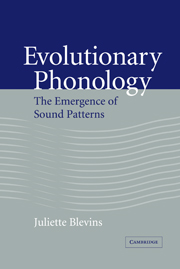3 - Explanation in phonology: a brief history of ideas
Published online by Cambridge University Press: 22 September 2009
Summary
The mechanism of a language (its structure and composition) at any given time is the result of all its preceding history and development, and each synchronic state determines in turn its further development.
Baudouin de Courtenay (1871/1972: 63)On enseigne partout qu'elles sont encore inconnues et mystérieuses. C'est inexact. Mais il n'y a pas une cause, il y en a un grand nombre, et l'erreur … a été … lorsqu'ils ont reconnu une cause de changements phonétiques, de croire qu'elle était la seule cause et de vouloir tout y ramener.
Grammont (1933: 174)The study of sound patterns goes back thousands of years. Pāɳini and his Indic contemporaries formulated phonetic laws and phonological rules over 2,000 years ago. Under the influence of Hindu and Chinese grammarians, King Seijong (1417–50) and his court advisors devised a writing system for Korean, hankul, which demonstrates a clear understanding of the phonemic principle and a sophisticated use of distinctive phonological features. Building on Chén Dì's (1541–1617) principle of historical change, early Qing dynasty scholars like Gù Yánw (1613–82) and Duàn Yùcái (1735–1815) made significant steps in the reconstruction of Old Chinese sound patterns. On the other side of the world, Sir William Jones (1746–94) observed in 1786 that Sanskrit, Greek, and Latin showed similarities of form suggestive of a family relationship. This observation inspired the European scholars Franz Bopp (1791–1867) and Jacob Grimm (1785–1863), forefathers of the neogrammarian movement.
- Type
- Chapter
- Information
- Evolutionary PhonologyThe Emergence of Sound Patterns, pp. 61 - 86Publisher: Cambridge University PressPrint publication year: 2004



